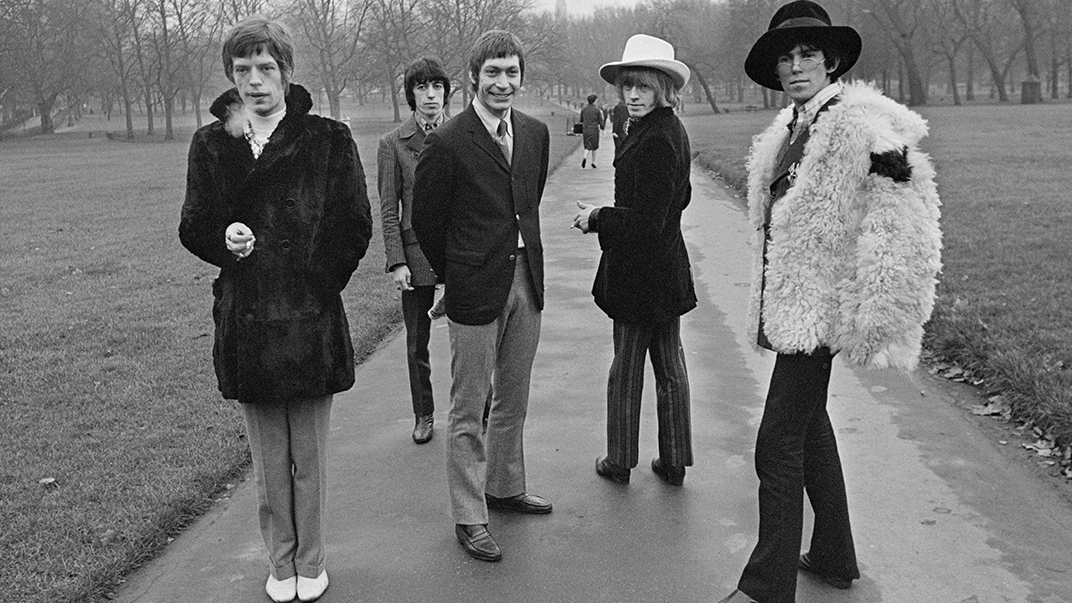This is the first time that The Rolling Stones’ 60s recordings – the UK and US versions of their albums, plus single A and B sides and EP cuts – have been available in one collection. That’s 186 tracks, 56 of which have not been heard in mono since rock went digital. In Mono includes every Stones album from 1964’s self-titled debut to 1969’s Let It Bleed as well as some of the most epochal 45s of the age, via a nifty 24-track compilation called Stray Cuts: Come On, Satisfaction, Paint It, Black, Jumpin’ Jack Flash, Honky Tonk Women. Or to put it another way: here is a concise history of rock’s second decade, for a measly 120 quid. And you get to experience it in all its turbulent glory, from Kennedy to Altamont, with the concentrated power and period fidelity you can only get from mono – remember, for most of the decade, stereo was something of a hi-fi novelty, with most music heard through just one channel.
By the late-60s, you could reasonably argue that stereo techniques had improved sufficiently to warrant your owning Their Satanic Majesties Request (1967), Beggars Banquet (1968) and Let It Bleed in both iterations. But if you want the visceral thrill of the Stones as they were enjoyed in real time, In Mono is the only way.
If you thought cool minimalist artwork was invented by Factory Records circa Joy Division’s Unknown Pleasures, try the front cover of debut The Rolling Stones (known in the States as England’s Newest Hit Makers, with a different track listing, as per all the Stones albums up until Their Satanic Majesties). It features profiles of the Stones’ ugly-beautiful mugs in all their early surly magnificence, and not a jot else. Buy the In Mono CD box and you might just be able to make out, in tiny writing on the rear of the replica sleeve, another presumed 70s concept: 10 years ahead of Malcolm McLaren, it’s the ravings of hypemaster (and manager) Andrew Loog Oldham, who proclaims the Stones “more than just a group – they are a way of life”.
The music is more of a throwback, with its amphetamine simulacrums of blues, Motown and Chuck Berry, although there is one example of the nascent Mick Jagger-Keith Richards songwriting partnership in the poppy Tell Me (You’re Coming Back) as well as two compositions by the group (aka Nanker Phelge). There’s no disputing the raw attack and sheer urgency of a record produced – by Oldham and co-manager Eric Easton – in five days at London’s Regent Sound Studios. I’m A King Bee unveils Jagger’s satyric – or should that be satiric? – sexual posturing while Honest I Do features possibly the last recorded instance of him pleading to a woman. If the fuzztone wallop of The Rolling Stones sounds dated today, it certainly caught the mood of the moment, becoming one of 1964’s biggest sellers in the UK and occupying the No.1 slot for 12 weeks. The Rolling Stones No 2 (10 weeks at No.1 in 1965) and US releases 12 X 5 (1964) and The Rolling Stones Now! (1965) complete the picture of the Stones in their primordial pomp, even if they were more respectful than irreverent, with their quarter-century-old covers of boogie-woogie standards (Don Raye’s Down The Road Apiece), while jaunty self-written numbers such as Off The Hook somewhat belied the mean moodiness of the David Bailey No 2 cover image.
Out Of Our Heads (1965) and contemporaneous US release December’s Children (And Everybody’s) were transitional affairs, but there was much to recommend, notably the Dylanesque whimsy of The Under Assistant West Coast Promotion Man. That’s How Strong My Love Is confirmed Jagger’s ability to fake soulful sincerity – his mannered vocals across a range of genres posited him as rock’s premier chameleon ahead of Bowie. December’s Children included Get Off Of My Cloud, a showcase for Charlie Watts’ complex drumming, and As Tears Go By was a florid, baroque departure for a band who a year before had been mired in the blues.
- The Rolling Stones Quiz
- The top 10 best Mick Jagger Rolling Stones songs
- The Rolling Stones – 50 Years Of Rock'n'roll
- Rolling Stones albums ranked from worst to best
Aftermath (1966) and non-album single Paint It, Black – driven by Brian Jones’ sitar – are widely regarded as breakthroughs: first album to feature an 11-minute track (Going Home), first to include all Jagger-Richards material. Its 14 non-originals represented a considerable advance for the future Glimmer Twins, while Jones set the adventurous tone with his wide-ranging use of ethnic instruments such as marimba, Appalachian dulcimer and organ.
It was also on Aftermath that Jagger, arguably the least innovative of the mid-60s titans (Dylan, Lennon, McCartney, Wilson, Townshend, Davies), evinced the further flowering of his greatest formal invention: his malevolent outsider persona. Unveiled on those early albums, it now assumed greater weight as he tapped into dark currents at large in the world. Under My Thumb and Stupid Girl saw him sidetracked by petty misogyny, but diazepam daydream Mother’s Little Helper and especially Paint It, Black (on the US version) suggested that Jagger didn’t just intend to evoke societal panic, he aimed to incite it.
If 1966 is seen as a landmark year for the Rolling Stones, 1967 is supposedly where they got derailed by psych faddishness. But frankly that does a great disservice to Between The Buttons, and not just because of its classic Gered Mankowitz cover photo of the band in a state of druggy delirium on Primrose Hill. It includes My Obsession (a favourite of Brian Wilson, who attended the recording session at Los Angeles’ RCA Studios), Connection – a proto-70s rocker bearing Richards’ imprimatur – and the swaggering Miss Amanda Jones. The attendant singles – the Let’s Spend The Night Together/Ruby Tuesday double-A-side, Have You Seen Your Mother, Baby, Standing In The Shadow?, all collected on 1967 US compilation Flowers – were largely untouched by any voguish trends. As for Their Satanic Majesties Request, it is generally dismissed for its overt Beatles mimicry, but if anything Sing This All Together sounds like Andrew Lloyd Webber envisioning a musical on acid and 2000 Light Years From Home is more Pink Floyd’s Piper than Pepper.
In 1968, an awareness of heritage was the new leap forward: John Lennon sang Yer Blues, The Band made Music From Big Pink, Dylan simplified matters on John Wesley Harding, even The Beach Boys wanted to Do It Again – all restatements of first principles. But if the Stones went back to basics on the Jimmy Miller-helmed Beggars Banquet (presented here in its full men’s bog regalia), it remains a far more sophisticated take on roots music than their crudely rampaging early efforts. It’s a classic of country, blues, country-blues and Americana – not bad for a bunch of oiks from Dartford and surrounding environs – although Jagger plays both musicologist and pasticheur, his stylised drawl on Dear Doctor and Prodigal Son suggesting an ironic distance that he would make up on Sticky Fingers’ Wild Horses (as for Stray Cat Blues, well, it might cause more than passing consternation at Yewtree HQ).
Still, Beggars, and follow-up Let It Bleed, remain defining artefacts of the counterculture, their four best-known tracks – Sympathy For The Devil, Street Fighting Man, Gimme Shelter and Midnight Rambler – chillingly capturing convulsions at home and abroad and connoting dread more authentically than any death metal. Let It Bleed presents a tableau of the Stones as emperors of their own licentious empire, a variety of players – Leon Russell, Ry Cooder, Al Kooper – bringing a sloppy precision to this dissolute superjam.
The album climaxed with You Can’t Always Get What You Want. It bid a weary adieu to peace and love and offered a warily optimistic assent to the next phase. Say goodbye, mono 60s, say hello, stereo 70s.
66 from '66 – The Rolling Stones
Does Keef still want to be in the Rolling Stones?
The Story Behind The Song: Gimme Shelter by the Rolling Stones

